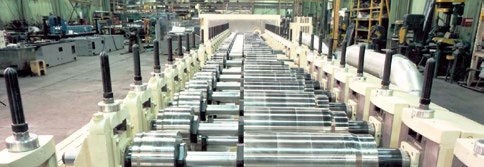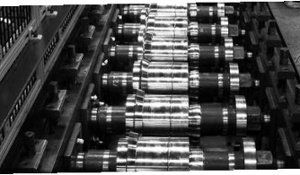The installation of a roll forming line is generally based around the fabrication of a particular metal part, based on the contractor's operations and needs. The complete roll forming line can become one of two approaches to the processing of a particular part; It can be arranged to produce that part:
- From precut lengths, or
- From coiled strip.
Some parts demand the cut length approach; however, the most efficient, productive, consistent, and reliable arrangement is the coil fed line. It most often consists of a coil reel, roll forming machine, cutoff machine and run-out table. This is the basic concept applying to the majority of installations in the world. A more complex arrangement might be provided whereby auxiliary operations, such as prenotching, punching, embossing, marking, trimming, seam welding, spot welding, curving and coiling are performed continuously, with the result that a minimum of subsequent operating procedures might be involved to provide the finished NET product.
Roll Forming Line Configurations

This figure shows a 26-pass machine for producing a refrigerator pane from precut, trimmed, prepunched lengths.

The next figure is a typical basic, coil fed line using a coil reel, a 11-stand forming mill and a 4- post type pneumatic cutoff press.

This final figure shows a prenotch, form and cut line. This, you see, includes not only the cutoff machine after the rolling machine but also another cutoff, in this case, termed a prenotch press, and a small stock straightener ahead of it. Although used most generally for developing a contoured end formation that cannot be developed after the shape is formed, this system can be used to prepunch many repetitive pattern combinations.
Number and Caliber of Roll Forming Line Operators
A roll forming line of average proportions, usually is operated by a single operator. Depending on the number of machines in the plant, this operator may or may not be capable of making a roll setup. As lines increase in complexity or as the shape gets longer, wider or heavier, depending upon the degree of automation, a helper may be added to the picture to assist in coil loading or part handling. Sometimes, a roll forming machine is “operator-less” and simply functions as a conveyor between operations. An example of this is the typical refrigerator panel line wherein the flat sheet is automatically conveyed from the trim and notch press to the forming machine and also from the forming machine to the tangent bender.
It is often assumed that a roll forming machine operator must be a “Jack of all trades”. This may be far-fetched, although on some troubleshooting occasions, such attributes might help. The operator should be a good mechanic capable of accepting and utilizing such training as is made available. They do not have to be a tool-maker, as this phase or work has already been accomplished for them.



